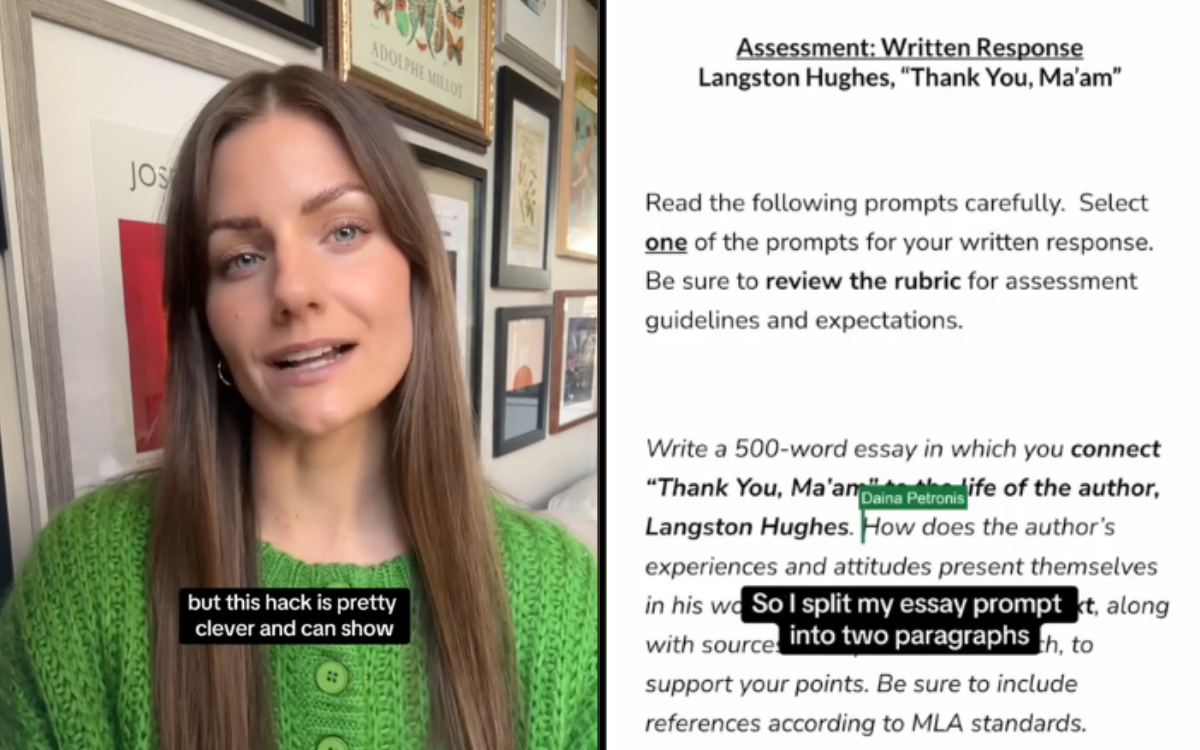A leading educator has shared a simple hack for catching out students using ChatGPT to write their essays for them.
Though ChatGPT's terms of use say those aged 13 to 18 should only use it with parental permission, research suggests a worrying number of students are already misusing AI in the classroom.
Earlier this month, a survey conducted by the Center for Democracy and Technology revealed a significant increase in U.S. student discipline issues related to the use of generative AI chatbots.
The nationally representative surveys of K-12 public school teachers found 64 percent said students at their school had got into trouble for using or being accused of using AI on a school assignment. That represented a 16 percent increase on the previous year.
Daina Petronis is a full-time curriculum designer and former high school English teacher who runs the online teaching resources community mondaysmadeeasy.com. She believes that while there may come a day when the likes of ChapGPT have a place in the classroom, right now the biggest challenge facing teachers when it comes to language learning models (LLMs) is their potential misuse.
"In theory, LLMs can benefit learning, but there needs to be plenty of support in place to ensure that they are not being misused," Petronis told Newsweek.

Much of Petronis's work involves researching trends in education, not least when it comes to the use of ChatGPT, the methods available to help teachers catch those using LLMs illicitly, and the limitations around them.
"I am often approached by companies developing AI-detection tools who are looking to promote their software to my audience," she said. "Before sharing these tools with my community, I always ask their representatives about their accuracy. The consistent response from these companies is that there is no surefire method to detect AI."
Another method endorsed by some involves asking the LLM if it produced the work in question. "I've actually tested this with several samples of original writing alongside text generated by an LLM," Petronis said. "I used my own writing that was published years ago and it falsely claimed to have generated it. I also used the writing that it had generated, and it didn't recognize it."
Thankfully, Petronis has hit upon a much simpler approach at weeding out the cheats using what she calls a "trojan horse" hack. In a video posted to her TikTok account mondaysmadeeasy, she explained "this hack is pretty clever and can show you exactly what to look out for without the use of any software of special programs."
She begins by splitting her essay prompt—the title of the essay given to her students—into two paragraphs before adding a sentence in-between in white using the smallest size possible. The idea is that if the essay prompt is copied and pasted into ChatGPT, the teacher can then search for the sentence hidden in the small white font when the assignment is submitted.
Though the video has been watched over one million times, garnering plenty of praise in the process, Petronis acknowledges there are "limitations" to the method.
"If a student happens to notice that there is hidden text in their assignment prompt, then there are some possible outcomes: they can either remove the text or mistake it as a part of the instructions," she said.
However, she feels the positives far outweigh the negatives. "What makes the trojan horse arguably more effective than other methods is that it offers a point of reference that is easy to identify and discuss with a student," she said. "I would not feel comfortable talking to a student about their writing process just because an AI detection tool or an LLM indicates that it's been plagiarized. But if I saw that their work had my trojan horse terms in it, I could simply ask them about it in an open-ended way."
Though the clip has been praised for highlighting a simple way to tackle plagiarism, Petronis said some watching the clip "misunderstood" the message of the video as being "anti-AI." Petronis refutes this suggestion.
"Even though this video sparked a lot of controversy, I think many of us have the same goal—we want what is best for students," she said. "While some people believe this involves training children on AI so that they can use it in the workforce, educators also understand literacy to be a more valuable skill and a prerequisite for using AI appropriately."
Uncommon Knowledge
Newsweek is committed to challenging conventional wisdom and finding connections in the search for common ground.
Newsweek is committed to challenging conventional wisdom and finding connections in the search for common ground.
About the writer
Jack Beresford is a Newsweek Senior Internet Culture & Trends Reporter, based in London, UK. His focus is reporting on ... Read more
To read how Newsweek uses AI as a newsroom tool, Click here.








